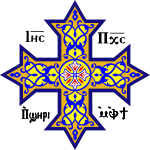- Monastery of Saint Matthew the Potter
-
The Monastery of Saint Matthew the Potter, also known as the Monastery of Saint Matthew the Poor, is a Coptic Orthodox monastery in Upper Egypt. It was founded by a Coptic monk of the same name. It is located in Luxor Governorate near the town of Naq 'al-Zinaiqa, about seven kilometers northwest of the village of Asfun al-Matana near Esna. The monastery is built on the edge of the desert. It was uninhabited for a period of time, but has been newly re-inhabited by Coptic Orthodox monks since 1975. Excavations done by French archeologists between the Monastery of Saint Matthew the Poor and the Monastery of the Martyrs have revealed much about the history of Coptic monasticism in this region.
Contents
History
The monastery was built in the 8th century by the monk Matthew the Potter, also known as Matthew the Poor, during the papacy of Pope Alexander II of Alexandria (704 AD - 729 AD). The story of the monastery’s construction is recounted in the History of the Patriarchs.
The monastery was destroyed in the 10th century by the Bedouin Arabs during one of their many raids on the Nile Valley and on Christian monasteries. Although it was rebuilt, the monastery became deserted a while later.
Al-Maqrizi wrote about the Monastery of Saint Matthew the Potter in the 15th century saying:
“ At Asfun, there was a large monastery, and Asfun was one of the finest towns in Egypt, and the monks of the monastery there were famous for their learning and intelligence. With Asfun, its monastery was also destroyed, and this was the most remote of the monasteries in Upper Egypt. ” When Lefort visited the monastery in 1939, he considered it to be one of the finest testimonies of ancient monastic life in the Nile Valley.
The monastery has been newly re-inhabited by a small number of Coptic Orthodox monks since 1975.
Architecture
The monastery has a striking, massive three stories-high tower that extends well above its enclosure walls. As is the case in other Coptic monasteries, the tower is accessible through a drawbridge that gets lifted when the monks take refuge in it from desert plunderers. The topmost floor of the tower contains a chapel dedicated the Archangel Michael, who is the traditional defender of Coptic monasteries.
The principal church of the monastery has a triple sanctuary. From north to south, the three sanctuaries are dedicated to Archangel Michael, Saint Matthew the Potter, and the Holy Virgin Mary. There is a square naos in the center of the building, roofed with a cupola and surrounded on each of its four sides by an ambulatory. The eastern ambulatory was used as a choir. The central square and the choir are the oldest components of the church, both probably dating to the 8th century, though restored at the end of the 12th century.
The wall paintings that adorn the sanctuaries and the central area of the naos are in very bad and fragmentary condition, because of vandalism over the last forty years. They date mostly from the eleventh to the fifteenth centuries. The themes of the paintings include Christ and the apostles, Saint Psote, Saint John the Baptist, in addition to various angles, archangels and prophets. The tomb of Saint Matthew the Potter is in a small space on the north side of the church, where tradition holds that he was buried in a clay casket.
The cells for the monks and the refectory are located in the southern wing of the monastery. The cells are situated on either side of a long vaulted corridor in a two story building. Originally, each cell accommodated several monks. The vaulted corridor gives access to the refectory, which is a vast square room with four pillars that support a roof of nine cupolas over nine bays. The kitchens are on the west side of the refectory.
Tombs
There are several Christian tombs in front of the monastery. These tombs are architecturally interesting because of their picturesque cupolas and crosses. These tombs are believed to date from the 14th and 15th centuries.
See also
- Saint Matthew the Potter
- Coptic Orthodox Church
- Coptic monasticism
References
- 2000 Years of Coptic Christianity. By Meinardus, Otto F. A. 1999. American University in Cairo Press. ISBN 977 424 5113.
- Christian Egypt: Coptic Art and Monuments Through Two Millennia. By Capuani, Massimo. 1999. Liturgical Press. ISBN 0-8146-2406-5.
- Churches and Monasteries of Egypt and Some Neigbouring Countries. By Abu Salih the Armenian. Edited and Translated by Evetts, B.T.A. 2001. Gorgias Press. ISBN 0-9715986-7-3.
External Links
Upper Egypt: Monastery of Saint Epiphanius · Monastery of Saint Fana · Monastery of the Martyrs · Monastery of Saint Matthew the Potter · Red Monastery · White Monastery
Middle Egypt: Monastery of Saint ParsomaLower Egypt: Eastern Desert: Scetes: Monastery of Saint Macarius the Great · Monastery of Saint Pishoy · Paromeos Monastery · Syrian MonasterySinai: Category – Christianity in Egypt – Monasteries by country Categories:- Christian monasteries in Egypt
- Coptic Orthodox monasteries
- Christian monasteries established in the 8th century
Wikimedia Foundation. 2010.
